Saint Maria Gorretti
![]()
Feast Day: July 16th

Saint Maria Gorretti
Mary Goretti was born in 1890 at Corinaldo, a village some thirty miles from Ancona, the daughter of a farm-labourer, Luigi Goretti, and his wife Assunta Carlini. They had five other children, and in 1896 the family moved to Colle Gianturco, near Galiano, and later to Ferriere di Conca, not far from Nettuno in the Roman Campagna. Almost at once after setting down here, Luigi Goretti was stricken with malaria and died. His widow had to take up his work as best she could, but it was a hard struggle and every small coin and bit of food had to be looked at twice. Of all the children none was more cheerful and encouraging to her mother than Mary, commonly called Marietta.
On a hot afternoon in July 1902 Mary was sitting at the top of the stairs in the cottage, mending a shirt. She was not yet quite twelve years old, and it must be remembered that in Italy girls mature earlier than in more northern countries. Presently a cart stopped outside, and a neighbour, a young man of eighteen named Alexander, ran up the stairs. He beckoned Mary into an adjoining bedroom; but this sort of thing had happened before and she refused to go. Alexander seized hold of her, pulled her in, and shut the door.
Mary struggled and tried to call for help, but she was being half-strangled and could only protest hoarsely, gasping that she would be killed rather than submit. Whereupon Alexander half pulled her dress from her body and began striking at her blindly with a long dagger. She sank to the floor, crying out that she was being killed: Alexander plunged the dagger into her back, and ran away.
An ambulance fetched Mary to hospital, where it was seen at once that she could not possibly live. Her last hours were most touching - her concern for where her mother was going to sleep, her forgiveness of her murderer (and she now disclosed that she had long been going in fear of him, but did not like to say anything lest she cause trouble with his family), her childlike welcoming of the holy viaticum. Some twenty-four hours after the assult, Mary Goretti died. Her mother, the parish priest of Nettuno, a Spanish noblewoman and two nuns, had watched by her bed all night.
Alexander was sentenced to thirty years' penal servitude. For long he was surly, brutal and unrepentant. Then one night he had a dream or vision in which Mary Goretti appeared gathering flowers and offering them to him. From then on he was a changed man, and so exemplary a prisoner that at the end of twenty-seven years he was released. His first act when free was to visit Mary's mother to beg her forgiveness.
Meanwhile the memory of his victim had become more and more revered. The sweetness and strength of her life before her untimely end was recalled, people prayed for her intercession in Heaven, answers, even miracles, were attributed to that intercession, and in response to a widespread wish the cause of her beatification was introduced. On April 27, 1947, Mary Goretti was declared blessed by Pope Pius XII. When he afterwards appeared on the balcony of St. Peter's he was accompanied by Mary's mother, Assunta Goretti, then eighty-two years old, together with two of Mary's sisters and a brother. Pilgrims came from all over Italy and the pope addressed them, presenting Bd Mary as a new St. Agnes and calling down woe on the corrupters of chastity in press and theatre and cinema and fasion-studio: "in our day", he said, "women have been thrown even into military service - with grave consequences." Three years later the same pope canonized Mary Goretti, in the piazza of St. Peter's, before the biggest crowd ever assembled for a canonization. Her murderer was still alive.
A number of "popular" canonizations of early times notwithstanding, a violent and unjust death alone is not sufficient to constitute martyrdom. (The common idea that St. Joan of Arc, for example, was a martyr is mistaken.) But St. Mary Goretti was killed in defence of a Christian virtue, and so was every bit as much a martyr as if she had died for the Christian faith. And it was Cardinal Salotti's opinion that, "Even had she not been a martyr she would still have been a saint, so holy was her everyday life".
![]()
The case of Mary Goretti seems to be unique in hagiology, and at the time of the beatification her short and moving story was noticed in the newspaper press of the world, from London Times downwards. Among the published accounts of her in English are those of Mother C.E. Maguire, Father J. Carr and Marie C. Buehrle. In L'art sacré, May-June 1951, p. 14. are printed some pictures illustrating the iconographical evolution of the saint. There is a good essay by Eric B. Strauss in Saints and Ourselves (1953).
![]()
Courtesy of TraditionalCatholic.net
![]()
Prayer I
Charming Saint, and true child of Mary, Mother of Jesus, you were so young but already so strong in resisting a cruel tempter and preferring to die a martyr. How greatly we need today - when chastity is often discarded - more models and intercessors like you! Multiply faithful Children of Mary for her glory and that of her Son. Amen.
Saint Maria Goretti, strengthened by God's grace, you did not hesitate, even at the age of eleven, to sacrifice life itself to defend your virginal purity. Look graciously on the unhappy human race that has strayed far from the path of eternal salvation. Teach us all, and especially our youth, the courage and promptness that will help us avoid anything that could offend Jesus. Obtain for me a great horror of sin, so that I may live a holy life on earth and win eternal glory in heaven. Amen.